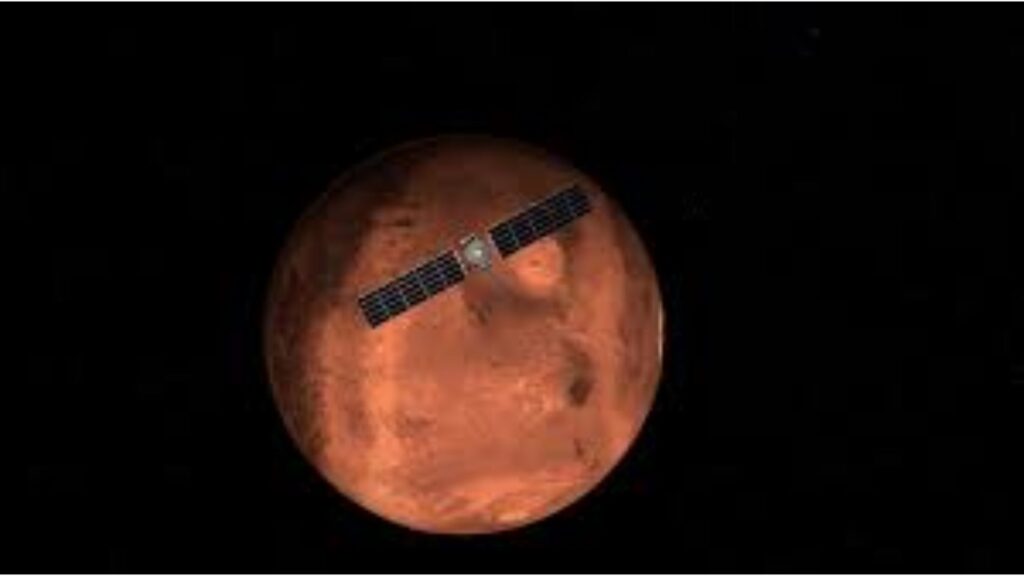NASA’s Europa Clipper spacecraft recently completed a critical milestone on its journey to Jupiter’s moon Europa, using a close flyby of Mars to both refine its trajectory and test key scientific instruments. During its March 1 approach, the spacecraft flew just 550 miles (884 kilometers) above the Martian surface, taking the opportunity to calibrate its thermal imaging camera by capturing infrared images of the Red Planet.
This maneuver was more than just a navigational boost. For about 18 minutes, the Europa Thermal Imaging System (E-THEMIS) took over a thousand infrared images—one every second. These grayscale images were later assembled into a global thermal map of Mars and colorized to show temperature variations, with red indicating warmer areas and blue representing colder regions. Scientists are using the data to evaluate the camera’s performance by comparing it with decades of thermal data collected by NASA’s Mars Odyssey orbiter, which carries a nearly identical instrument.
“Our aim was to see exactly what we expected,” said Phil Christensen of Arizona State University, principal investigator for E-THEMIS. “Mars is well-documented, so it’s an ideal target to ensure E-THEMIS is functioning as designed.”
Europa Clipper’s main mission is to study Europa, one of Jupiter’s largest moons, known for its subsurface ocean hidden beneath a thick icy crust. Scientists believe this ocean may harbor conditions suitable for life. The spacecraft will arrive at the Jupiter system in 2030 and begin conducting 49 close flybys of Europa over the following year.
Thermal imaging is a key tool in this investigation. By mapping surface temperatures, E-THEMIS will help detect geologic activity, such as fractures or ridges where ocean water might be interacting with the icy shell. These areas are expected to be warmer and may indicate recent or ongoing activity.
“If Europa is geologically active, we’ll see that in temperature variations,” Christensen explained. “Even features formed hundreds or thousands of years ago might still emit detectable heat.”
The Mars flyby also allowed engineers to conduct the first full in-space test of Europa Clipper’s radar instrument, which is designed to probe beneath Europa’s icy surface. This system uses long-wavelength radar waves that couldn’t be fully tested before launch. Initial telemetry from the test appears promising, with detailed analysis to follow in the coming months.
In addition, mission teams used the flyby to confirm that the spacecraft’s telecommunications system can support gravity science experiments. By observing signal behavior as Europa Clipper passed through Mars’ gravitational field, scientists gained confidence that similar measurements will be successful during flybys of Europa.
Launched on October 14, 2024, aboard a SpaceX Falcon Heavy rocket from NASA’s Kennedy Space Center, Europa Clipper is on a 1.8 billion-mile (2.9 billion-kilometer) journey to Jupiter. Following its Mars assist, the spacecraft is now headed for an Earth gravity assist in 2026, which will further refine its trajectory toward the outer solar system.
The mission has three primary science goals: to determine the thickness of Europa’s ice shell and its interactions with the ocean below, investigate the moon’s composition, and study its surface geology. These investigations will help assess Europa’s potential to support life.
Europa Clipper is managed by NASA’s Jet Propulsion Laboratory in Southern California, with significant contributions from the Johns Hopkins Applied Physics Laboratory, NASA’s Goddard Space Flight Center, Marshall Space Flight Center, and Langley Research Center. The mission represents a major step in humanity’s quest to explore potentially habitable environments beyond Earth.
